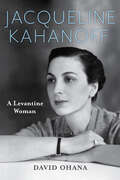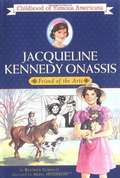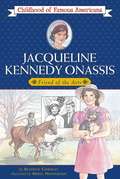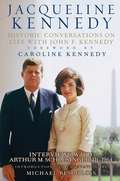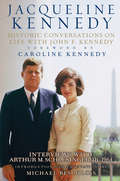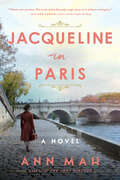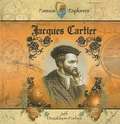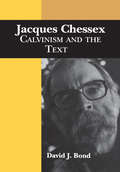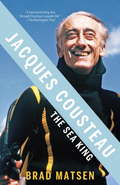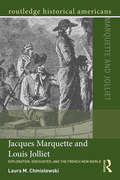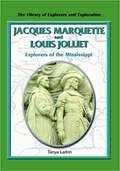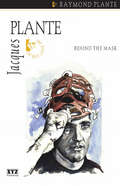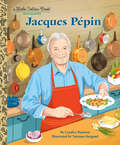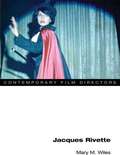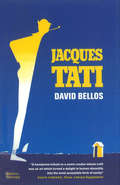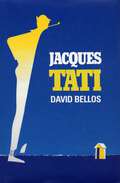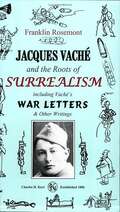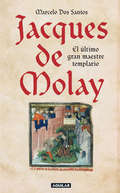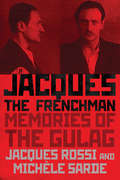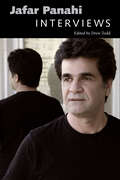- Table View
- List View
Jacqueline Kahanoff: A Levantine Woman (Perspectives on Israel Studies)
by David OhanaJacqueline Kahanoff: A Levantine Woman is the first intellectual biography of this remarkable Egyptian-Jewish intellectual, whose work has secured her place in literary pantheon as a herald of Levantine, Mediterranean, and transnational culture. Growing up Jewish in cosmopolitan Egypt in the 1920s and 1930s, Jacqueline Kahanoff experienced a bustling Middle East enriched by diverse languages, religions, and peoples who nonetheless were deeply connected to each other through history, business, daily practices, and shared landscape. At the age of twenty-four, Kahanoff immigrated to the United States. Her stories, essays, and short autobiographical novel attest to her penchant to cross boundaries, generations, social classes, sexes, and Western and Eastern constructs. After immigrating to Israel in the early 1950s, she critically addressed the country's "provinciality" and "ethnic nationalism" as seen through her conception of a transnational Levantine culture. Through many writings, Kahanoff set forth her distinctive vision of Israel as a Mediterranean country with a broad, multicultural Levantine identity. Drawing on an extensive array of sources, ranging from interviews with Jacqueline Kahanoff's acquaintances and contemporaries to unpublished writings, David Ohana explores her fascinating life and intellectual journey from Cairo to Tel Aviv. The encompassing vision of a Levantine Israel made Kahanoff the initiator of a different cultural possibility, more extensive than that offered in her time, and also, perhaps, than is offered today.
Jacqueline Kennedy Onassis: Friend of the Arts (Childhood of Famous Americans Series)
by Beatrice GormleyThese classics have been praised alike by parents, teachers, and librarians. With these lively, inspiring, fictionalized biographies -- easily read by children of eight and up -- today's youngster is swept right into history.
Jacqueline Kennedy Onassis: Friend of the Arts (Childhood of Famous Americans Series)
by Beatrice GormleyThese classics have been praised alike by parents, teachers, and librarians. With these lively, inspiring, fictionalized biographies -- easily read by children of eight and up -- today's youngster is swept right into history.
Jacqueline Kennedy: Conversaciones históricas sobre mi vida con John F. Kennedy
by Jacqueline KennedyJacqueline Kennedy nos habla por primera vez de su vida con JFK. Un testimonio histórico que sale ahora a la luz en esta edición coordinada por su hija Caroline. Poco después del asesinato de John F. Kennedy, con la nación entera de luto y en un ambiente de fuerte conmoción internacional, Jacqueline Kennedy encontró la fortaleza necesaria para dejar de lado su dolor y contribuir a mantener vivo el legado de su marido. En enero de 1964 ella y su cuñado, Robert F. Kennedy, aprobaron un proyecto de historia oral que recogiera los acontecimientos más reseñables de la presidencia de Kennedy como ejemplo para las futuras generaciones. A principios de marzo la que fuera primera dama de Norteamérica se sentó junto al historiador y premio Pulitzer, Arthur Schlesinger Jr., para hablar de las aspiraciones políticas de Kennedy, los primeros años de casados, su carácter, los hábitos de lectura de JFK, sus héroes de infancia, la vida en la Casa Blanca,la revolución cubana o Bahía Cochinos, entre otros muchos temas. Aquellas cintas fueron grabadas y la información que contenía nunca se publicó. Hoy, 50 años después, y gracias al impulso de su hija Caroline salen a la luz. Jacqueline Kennedy. Conversaciones históricas sobre mi vida con John F. Kennedy es una obra de historia oral -trufada de fotografías personales e inéditas- que da voz a uno de los testigos cruciales de aquel tiempo, una mujer que por desgracia ha estado ausente en todos los libros que se han escrito sobre John F. Kennedy hasta el momento. Ahora le toca hablar a ella, a Jacqueline Kennedy. La mañana de su muerte, el 19 de mayo de 1994, The New York Times destacaba el silencio que siempre guardó sobre su pasado, es más sus años junto a Kennedy y su matrimonio fueron siempre un misterio. Estas conversaciones son un documento magistral, una lección de historia y una confesión íntima que supone el final del silencio. «Grabadas menos de cuatro meses después de la muerte de su marido, estas conversaciones suponen un regalo para la posteridad y una muestra de amor. Mis hijos y yo hemos decidido publicarlas ahora con motivo del 50 aniversario de la presidencia de mi padre. Espero que las generaciones futuras encuentren en estos recuerdos inspiración».
Jacqueline Kennedy: Historic Conversations on Life with John F. Kennedy
by Michael Beschloss Caroline KennedyWhile reading Arthur Schlesinger, Jr. 's interviews of Jacqueline Kennedy, readers will be able to go back in time 50 years, and feel like they are part of a conversation between two old friends. The text includes complete transcripts of Jacqueline's interviews that allows readers a window into an important time in American history; it also has accompanying annotations from leading presidential historian Michael Beschloss which informs readers on political details of the era.
Jacqueline Kennedy: Historic Conversations on Life with John F. Kennedy
by Caroline KennedyIn 1964, Jacqueline Kennedy recorded seven historic interviews about her life with John F. Kennedy. Now, for the first time, they can be read in this deluxe, illustrated eBook.Shortly after President John F. Kennedy's assassination, with a nation deep in mourning and the world looking on in stunned disbelief, Jacqueline Kennedy found the strength to set aside her own personal grief for the sake of posterity and begin the task of documenting and preserving her husband's legacy. In January of 1964, she and Robert F. Kennedy approved a planned oral-history project that would capture their first-hand accounts of the late President as well as the recollections of those closest to him throughout his extraordinary political career. For the rest of her life, the famously private Jacqueline Kennedy steadfastly refused to discuss her memories of those years, but beginning that March, she fulfilled her obligation to future generations of Americans by sitting down with historian Arthur Schlesinger, Jr., and recording an astonishingly detailed and unvarnished account of her experiences and impressions as the wife and confidante of John F. Kennedy. The tapes of those sessions were then sealed and later deposited in the John F. Kennedy Presidential Library and Museum upon its completion, in accordance with Mrs. Kennedy's wishes.The resulting eight and a half hours of material comprises a unique and compelling record of a tumultuous era, providing fresh insights on the many significant people and events that shaped JFK's presidency but also shedding new light on the man behind the momentous decisions. Here are JFK's unscripted opinions on a host of revealing subjects, including his thoughts and feelings about his brothers Robert and Ted, and his take on world leaders past and present, giving us perhaps the most informed, genuine, and immediate portrait of John Fitzgerald Kennedy we shall ever have. Mrs. Kennedy's urbane perspective, her candor, and her flashes of wit also give us our clearest glimpse into the active mind of a remarkable First Lady.In conjunction with the fiftieth anniversary of President Kennedy's Inauguration, Caroline Kennedy and the Kennedy family are now releasing these beautifully restored recordings on CDs with accompanying transcripts. Introduced and annotated by renowned presidential historian Michael Beschloss, these interviews will add an exciting new dimension to our understanding and appreciation of President Kennedy and his time and make the past come alive through the words and voice of an eloquent eyewitness to history.
Jacqueline du Pré: A Life
by Carol EastonBiography of the English cellist, one of the world's greatest cellists, a legend in her own lifetime.
Jacqueline in Paris: A Novel
by Ann MahFrom the bestselling author of The Lost Vintage, a rare and dazzling portrait of Jacqueline Bouvier’s college year abroad in postwar Paris, an intimate and electrifying story of love and betrayal, and the coming-of-age of an American icon – before the world knew her as Jackie.In September 1949 Jacqueline Bouvier arrives in postwar Paris to begin her junior year abroad. She’s twenty years old, socially poised but financially precarious, and all too aware of her mother’s expectations that she make a brilliant match. Before relenting to family pressure, she has one year to herself far away from sleepy Vassar College and the rigid social circles of New York, a year to explore and absorb the luminous beauty of the City of Light. Jacqueline is immediately catapulted into an intoxicating new world of champagne and châteaux, art and avant-garde theater, cafés and jazz clubs. She strikes up a romance with a talented young writer who shares her love of literature and passion for culture – even though her mother would think him most unsuitable.But beneath the glitter and rush, France is a fragile place still haunted by the Occupation. Jacqueline lives in a rambling apartment with a widowed countess and her daughters, all of whom suffered as part of the French Resistance just a few years before. In the aftermath of World War II, Paris has become a nest of spies, and suspicion, deception, and betrayal lurk around every corner. Jacqueline is stunned to watch the rise of communism – anathema in America, but an active movement in France – never guessing she is witnessing the beginning of the political environment that will shape the rest of her life—and that of her future husband.Evocative, sensitive, and rich in historic detail, Jacqueline in Paris portrays the origin story of an American icon. Ann Mah brilliantly imagines the intellectual and aesthetic awakening of Jacqueline Bouvier Kennedy Onassis, and illuminates how France would prove to be her one true love, and one of the greatest influences on her life.
Jacques Cartier (Famous Explorers)
by Jeff Donaldson-ForbesBorn in a small fishing town in France, Jacques Cartier became an expert navigator and was chosen by King Francis I to lead an expedition in search of the elusive Northwest Passage. In this beautifully illustrated book, students will follow Cartier as he travels to Newfoundland, New Brunswick, and down the St. Lawrence River to the Iroquois village of Stadacona, which is now known as Quebec.
Jacques Chessex: Calvinism and the Text
by David J. BondDespite an impressive body of poems, novels, short stories, and literary criticism; high praise for his writing by French and Swiss critics; and a collection of honours that includes the prestigious Prix Goncourt, awarded for his novel L'Ogre in 1973, Jacques Chessex is relatively unknown outside France and Switzerland. With this book, David J. Bond provides the first comprehensive study of his work in any language--a study that reveals Chessex's deep ambivalence towards his Calvinist heritage and his efforts to resolve this dilemma through his texts.Born in 1934 in Payerne, in the region of French-speaking Switzerland known as the Vaud, Chessex grew up amid the pervasive influence of the Calvinist church. His writing, which tells of Vaud society and the hypocrisy of many of its leading members, reveals his preoccupation with a rigid morality, sin, remorse, and death. Bond shows that while Chessex uses his texts to escape this heritage and affirm alternative values, particularly sexual pleasure and enjoyment of life, his writing reveals a deep nostalgia for the stability and security of a strict religious system in a world that he finds unstable and even absurd without it. Chessex looks to the text as a univocal organizing principle that might impose order and sense. Bond sees in Chessex's writing an attempt to find unity in opposing values, to establish contact with others, and to overcome an obsession with death and the passing of time.
Jacques Cousteau: The Sea King
by Brad MatsenIn this balanced biography of Cousteau (1910-1997), Matsen (an author specializing in marine subjects) traces the life and contributions of the renowned marine explorer/filmmaker/ conservationist from his development of the Agua-Lung and undersea photography equipment to his public television documentary series, The Undersea World of Jacques Cousteau, and legal battles between his heirs. The book includes photographs of Cousteau, his two families, well-known ship The Calypso, scientific expeditions, and monument in his hometown in France. Annotation c2010 Book News, Inc. , Portland, OR (booknews. com)
Jacques Marquette and Louis Jolliet: Exploration, Encounter, and the French New World (Routledge Historical Americans)
by Laura M. ChmielewskiIn this succinct dual biography, Laura Chmielewski demonstrates how the lives of two French explorers – Jacques Marquette, a Jesuit missionary, and Louis Jolliet, a fur trapper – reveal the diverse world of early America. Following the explorers' epic journey through the center of the American continent, Marquette and Jolliet combines a story of discovery and encounter with the insights derived from recent historical scholarship. The story provides perspective on the different methods and goals of colonization and the role of Native Americans as active participants in this complex and uneven process.
Jacques Marquette and Louis Jolliet: Explorers of the Mississippi (Library of Explorers and Exploration)
by Tanya LarkinA biography of the French explorers whose primary goal was to find the Northwest Passage, but who made their mark on history by exploring and charting the Mississippi River.
Jacques Plante
by Vladimir Konieczny Raymond PlanteJacque Plante, the first National Hockey League goalie to regularly wear protective facemask, was known for roving out of his net. "The Masked Marvel" won the Vezina trophy seven times and became a member of the Hockey Hall of Fame.
Jacques Plante
by Todd DenaultThe first full-scale biography of a legendary and award-winning NHL goalie who transformed the game."There are a lot of very good goalies, there are even a fair number of great goalies. But there aren't many important goalies. And Jacques Plante was an important goalie." Ken DrydenOn and off the ice Jacques Plante was a true original; he was extremely talented, boastful, defiant, mysterious, and complex. Throughout his tumultuous career as a goalie, he played for Montreal, New York, St. Louis, Toronto, Boston, and Edmonton. His contributions to and impact on the game were extensive and are reflected in today's rules, equipment, and style of play. Thoroughly investigated through archival and primary research, and including interviews with figures such as Jean Béliveau, Henri Richard, Dickie Moore, and Scotty Bowman, this biography sheds light on one of the most pivotal figures in the history of hockey.From the Hardcover edition.
Jacques Pépin: A Little Golden Book Biography (Little Golden Book)
by Candice RansomDream big with a Little Golden Book biography about French chef Jacques Pépin, who taught countless fans how to cook french meals—and carve lemons into the shape of pigs. Little Golden Book biographies are the perfect introduction to nonfiction for young readers—as well as fans of all ages!This Little Golden Book about Jacques Pépin—the beloved French chef, artist, and close friend of Julia Child—is an inspiring read-aloud for young foodies and their parents.Look for more Little Golden Book biographies: • Harry Belafonte • Tony Bennett • Iris Apfel • Oprah Winfrey • Julia Child
Jacques Rivette (Contemporary Film Directors)
by Mary M. WilesAs a pioneer of the French New Wave, Jacques Rivette was one of a group of directors who permanently altered the world's perception of cinema by taking the camera out of the studios and into the streets. His films, including Paris nous appartient, Out 1: Noli me tangere, Céline et Julie vont en bateau--Phantom Ladies Over Paris, La belle noiseuse, Secret défense, and Va savoir are extraordinary combinations of intellectual depth, playfulness, and sensuous beauty. In this study of Rivette, Mary M. Wiles provides a thorough account of the director's career from the burgeoning French New Wave to the present day, focusing on the theatricality of Rivette's films and his explorations of the relationship between cinema and fine arts such as painting, literature, music, and dance. Wiles also explores the intellectual interests that shaped Rivette's approach to film, including Sartre's existentialism, Barthes's structuralism, and the radical theater of the 1960s. The volume concludes with Wiles's insightful interview with Rivette.
Jacques Schiffrin: A Publisher in Exile, from Pléiade to Pantheon
by Amos ReichmanJacques Schiffrin changed the face of publishing in the twentieth century. As the founder of Les Éditions de la Pléiade in Paris and cofounder of Pantheon Books in New York, he helped define a lasting canon of Western literature while also promoting new authors who shaped transatlantic intellectual life. In this first biography of Schiffrin, Amos Reichman tells the poignant story of a remarkable publisher and his dramatic travails across two continents.Just as he influenced the literary trajectory of the twentieth century, Schiffrin’s life was affected by its tumultuous events. Born in Baku in 1892, he fled after the Bolsheviks came to power, eventually settling in Paris, where he founded the Pléiade, which published elegant and affordable editions of literary classics as well as leading contemporary writers. After Vichy France passed anti-Jewish laws, Schiffrin fled to New York, later establishing Pantheon Books with Kurt Wolff, a German exile. Following Schiffrin’s death in 1950, his son André continued in his father’s footsteps, preserving and continuing a remarkable intellectual and cultural legacy at Pantheon. In addition to recounting Schiffrin’s life and times, Reichman describes his complex friendships with prominent figures including André Gide, Jean-Paul Sartre, Peggy Guggenheim, and Bernard Berenson. From the vantage point of Schiffrin’s extraordinary career, Reichman sheds new light on French and American literary culture, European exiles in the United States, and the transatlantic ties that transformed the world of publishing.
Jacques Tati
by David BellosThe full story of one of France's greatest cinema legends, a clown whose film-making innovation was to turn everyday life into an art form.Jacques Tati's Monsieur Hulot, unmistakable with his pipe, brolly and striped socks, was a creation of slapstick genius that made audiences around the world laugh at the sheer absurdity of life. This biography charts Tati's rise and fall, from his earliest beginnings as a music hall mime during the Depression, to the success of Jour de Fête and Mon Oncle, to Playtime, the grandiose masterpiece that left the once celebrated director bankrupt and begging for equipment to complete his final films. Analysing Tati's singular vision, Bellos reveals the intricate staging of his most famous gags and draws upon hitherto inaccessible archives to produce a unique assessment of his work and its context for film lovers and film students alike.
Jacques Tati His Life & Art
by David BellosJacques Tati's Monsieur Hulot, unmistakeable with his pipe, brolly and striped socks, was a creation of sheer slapstick genius that made audiences around the world laugh at the sheer absurdity of life. This biography charts Tati's rise and fall, from his earliest beginnings as a music hall mime during the Depression, to the success of Jour de Fete and Mon Oncle, to Playtime, the grandiose masterpiece that left the once delebrated director bankrupt and begging for equipment to complete his final films. Analysing Tati's singular vision, Bellos reveals the intricate staging of his most famous gags and draws upon hitherto inaccessible archives to produce a unique assessment of his work and its context for film lovers and film students alike.
Jacques Vache and the Roots of Surrealism: Including Vache's War Letters & Other Writings
by Franklin RosemontLiterary Nonfiction. Fiction. Biography. Conscripted into the French Army in World War One, Jacques Vache soon became not only the unsurpassed champion of "Desertion from Within," but also the master of "Disservice with Diligence." His post-humous slim book, War Letters (1919)--included in the present volume--is a classic of surrealist anti-militarism and subversion. Renowned as the Inventor of Umour (Humour without the H), Vache was--along with Isidore Ducasse, Comte de Lautreamont--the major inspirer of Andre Breton and the surrealist revolution. The first of its kind in English, this book chronicles Vache's boundless originality, creative nonconformity, revolutionary morality (or umoral-ity), and his all-out turn-the-world-upside-down hilarity. Welcomed by Andre Breton himself into the Paris Surrealist Group in 1966, Franklin Rosemont took part in the Paris group's activities for several months and went on to co-organize the Chicago Surrealist Group later that year. Rosemont (1943-2009) died earlier this year.
Jacques de Molay: El último gran maestre templario
by Marcelo Dos SantosConozca en este nuevo libro de Marcelo Dos Santos, autor de El manuscrito Voynich, la odisea de Jacques de Molay, último gran maestre de la Orden de los Templarios. A principios del siglo XIV la sociedad europea veía el imparable avance de las órdenes monásticomilitares. Los principales de entre estos miles de monjes guerreros eran los Caballeros Templarios (orden fundada en la Jerusalén recién conquistada en la cruzada) quienes fundaron verdaderos imperios espirituales y económicos en las sociedades europeas de su época. De estricta observancia religiosa, obediencia ciega a los reyes y al papado, valor a toda prueba y un enorme espíritu de sacrificio, los Templarios estaban obligados a aceptar el combate de uno contra tres, no podían comprar sus vidas con rescates si caían prisioneros y se les exigía cumplir con otras severísimas reglas. Además de ello, debían someterse a los tres votos tradicionales de los religiosos cristianos: obediencia, pobreza y castidad. Encontraron tiempo aún para dedicarse a la producción agrícola, a la construcción de muchas de las grandes catedrales europeas y a financiar grandes proyectos y emprendimientos. A pesar de todas sus virtudes, sin embargo, un buen día cayeron en desgracia y fueron aniquilados.
Jacques, the Frenchman: Memories of the Gulag
by Jacques Rossi Michele SardeJacques Rossi is one of Stalin’s most well-known victims. Author of The Gulag Handbook, a fascinating encyclopedia of the Soviet forced labor camps, Rossi spent twenty years in interrogation, prison, and Gulag detention. Born to a prominent Polish father and French mother, the young Jacques became attracted to communism as a blueprint for radical social reform. He spent years in the communist underground in interwar Europe, agitating for the revolution, but he was arrested during Stalin’s Great Purges in 1937. This book represents a conversation between Jacques Rossi and Michèle Sarde, professor emerita at Georgetown University, and weaves together personal reflections and historical analysis. Rossi’s remarkable life (1909–2004) spanned the twentieth century and sheds important light on the tumultuous history of Europe – the appeal of communism in the interwar period and beyond, the mentality of party members, the effects of mass repression, everyday life in Stalin’s Gulag, and the problem of rights for former prisoners during the Khrushchev era. As he abandoned his internationalist communist beliefs, Rossi increasingly identified as French, embracing the name his fellow prisoners gave him in the Gulag, "Jacques the Frenchman." Rossi’s reflections on his own political beliefs, his frustrations with those who could not accept the truth of his brutal experiences in the Soviet Union, and his life as a witness to one of the twentieth century’s worst crimes offer a fascinating history of Stalinism and its legacies.
Jafar Panahi: Interviews (Conversations with Filmmakers Series)
by Drew ToddIranian filmmaker Jafar Panahi (b. 1960) is as famous for his remarkable films as for his courageous defiance of Iran’s state censorship. Panahi achieved international recognition with his feature film debut, The White Balloon, the first Iranian film to receive an award at the Cannes Film Festival. His subsequent films—The Mirror, The Circle, and Offside—continue to receive acclaim throughout the world, yet they remain largely unseen in his own country due to years of conflict with the Iranian government. In spite of multiple arrests, a brief imprisonment, and a ban on making movies and giving interviews, Panahi speaks openly and passionately in this unique, invaluable collection of twenty-five interviews, open letters, and his own court statement, in which he makes a compelling case for artistic freedom and humanism. Many of these documents have been translated from Persian and appear in English for the first time, including an interview done exclusively for this volume. In sparkling, lively interviews, Panahi reveals his influences, politics, and filmmaking practices. He explains the challenges he faces while working within (and often around) Iran’s heavily restricted film industry, providing the reader a unique vantage point from which to consider Iranian cinema and society.
